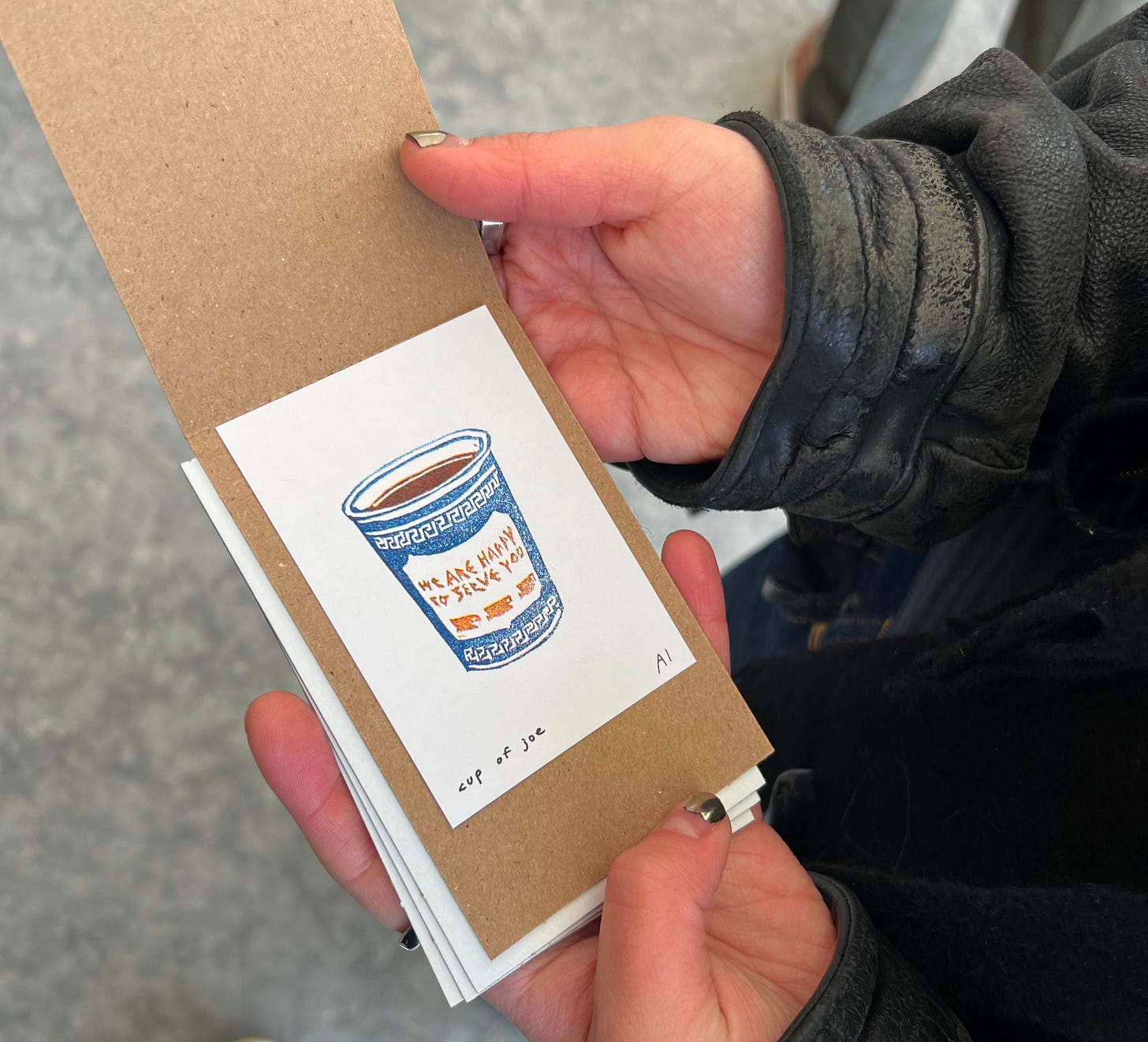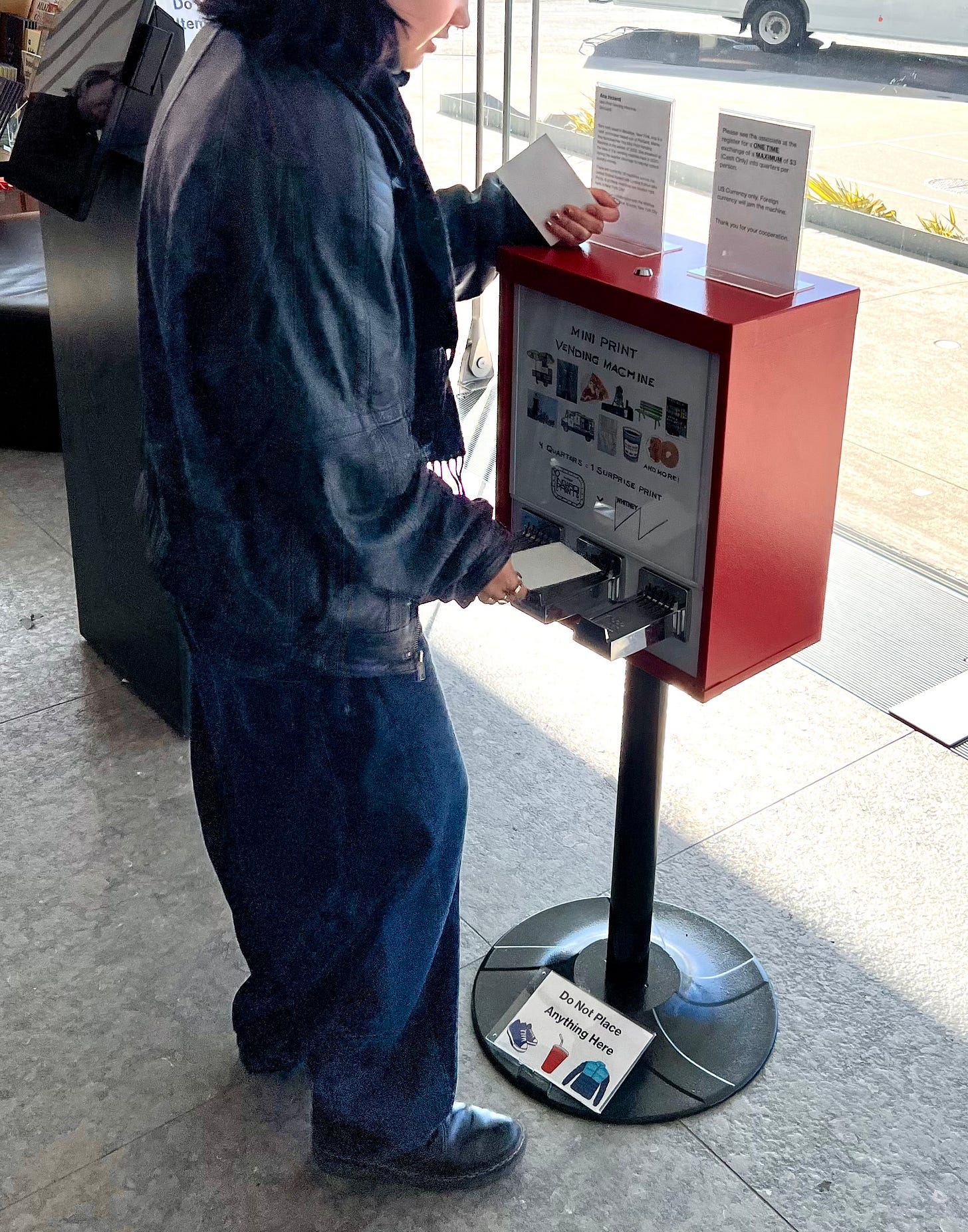The weather in New York has been confounding lately, neither lion nor lamb, but some fantastical hybrid, a sphinx or Chimera, each day somehow built from the business-minded body parts of each season. However I dress for outside gets proven wrong, as the lion’s head of early spring morning becomes the dragon wings of fall before I can make it home.
Q and I found ourselves walking through the snake tail of winter late into March as we headed to the Whitney Museum. We weren’t going for the exhibitions, however. Back in December, we read about a vending machine in Grand Central’s seasonal Holiday Market that gave a tiny random print in exchange for four quarters. This machine is the brainchild of Ana Inciardi, a graphic artist from Brooklyn who specializes in cute linocut prints mainly of food. She says she came up with the idea in 2020 during the pandemic while collecting quarters for laundry, and she also fondly remembered temporary tattoo machines from growing up in New York. Now she’s placed about 50 pedestal print vending machines in stores, restaurants, and museums across the U.S.
The Grand Central Holiday Market cycled out for another season before we could get there, but we discovered that machines were still exchanging quarters for prints throughout the city, including at the Whitney. New York slice shops and bodegas still love cash, and Q and I had already accumulated a mini gallery’s worth of quarters. We made our pockets heavy with change and headed across town to the museum.
The first floor of the Whitney is open plan and framed on three sides by tall glass. The gift shop is more like a gift corner, just low shelves of coffee table books and t- and sweatshirts spaced widely on pipe racks. We had some difficulty finding the vending machine at first, but there it was near the wall that lets in the West Side Highway and the Hudson River.
We waited briefly for others to finish their vending, and then we filled the slots of each slider with a metal dollar. We pushed the sliders in, heard the change fall satisfyingly into an internal catch, and, when we pulled the empty sliders back out, received small, white cardboard folders.
This little machine met all our expectations. Q loves anything miniature, always has, and these cute prints fit neatly in a journal, or folded into a letter to a friend just because you thought of them, or between the pages of your current book to take you quickly back to a story while reminding you of another. They also slide into almost any pocket, perfect for lurking in a coat to surprise the next time that season comes around.
If you’ve read this newsletter even a little, you’ll know that I’m highly susceptible to nostalgia. My childhood might as well have come vended out of a machine: I grew up in the arcade ’80s, often reserving an afternoon of joy and frustration with pillars of quarters set on a pinball or Galaga machine while my parents did whatever parents do in the mall. My personal soundtrack will always include the sound of coins falling through a slot in a machine giving me three lives or spitting out a surprise in a plastic bubble.
Still, nostalgia wasn’t the main draw and source of joy. I had to think about it for a while, but I realized that the whole experience was tactile and manual. We had to walk a good long ways just to get to the machine, and it only worked with quarters. The Whitney had set a sign on its top, firm and insistent in all-caps, bold, and underlined type, that its cashiers would exchange a MAXIMUM of $3 in cash for quarters, per person. Which is to say you better arrive prepared with either coins or bills — there’s no sensor to tap a phone or a card with a chip to get enjoyment now and reconcile payment later. You have to push in a mechanical thing (no touch screen or keyboard) to get a thing that is yours — no song or episode that disappears when your subscription lapses — that takes up physical space in your life. The prints are little, but you still have to put them somewhere.
The whole experience just had so much friction. Content, the defining quantum of our current moment, hates friction. Content likes the infinite scroll, the tortilla-chip post that always makes you want another as soon as you’ve had even one, the immediacy and economy of the meme, the notification hit. It’s all meant to be so easy, the phone screen an inviting infinity pool in which to soak ideally forever. Content is cheap, even free, valuable not for what it is but for what it does. How it makes you feel. A song, a tweet, a pic of a sandwich or a dog in a tie, a vid of friends unwinding the latest dance in a disheveled bedroom — all interchangeable bits of smooth screen to like and refresh and move on from and forget quickly.
We tend to meet content with more content, even in these times of meanness and suffering. Until this machine, I didn’t realize how much I wanted friction.
We fed the machine until we ran out of quarters. We opened the folders as they ejected to see cute prints of a New York slice of pizza, subway car, an ice cream truck (accented blue like the official NYC trucks), and the iconic Greek takeaway coffee cup. We only ended up with one duplicate (two subway cars). We snapped some pics for Instagram and the family group chat, then put our phones away and together headed back into the fire-breathing-goat part of the day. Q already had plans for her favorites (a fresh page in her journal, a letter to a new friend). I slid one of these new beautiful things (the pizza slice) into my inside coat pocket; I wasn’t sure what I would do with it. I did know that I wanted the feel of quarters in my hand, a long walk with someone I love, the active mechanisms of life.



Yes. oh my goodness, yes. Here's to friction and real things in our pockets and journals and letters. Thanks, Roblin. You never fail to delight.